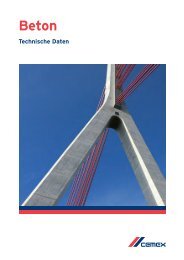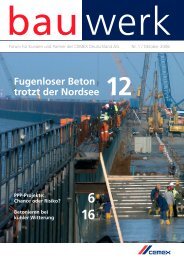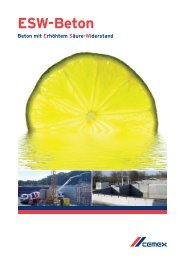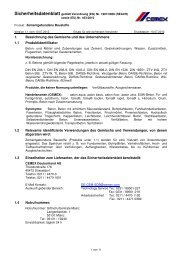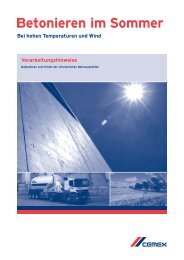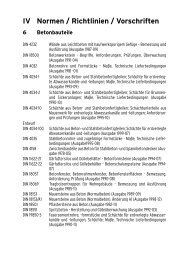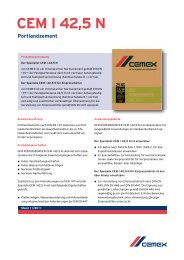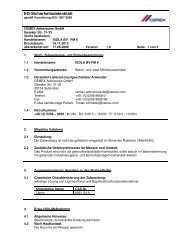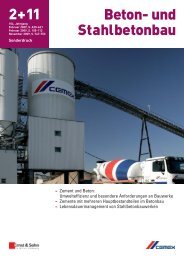building a better future - Cemex
building a better future - Cemex
building a better future - Cemex
You also want an ePaper? Increase the reach of your titles
YUMPU automatically turns print PDFs into web optimized ePapers that Google loves.
our approach<br />
CEMEX operates in an energy-intensive industry facing<br />
several environmental challenges. Given this reality, applying<br />
a comprehensive carbon strategy is at once a necessity<br />
and an opportunity for our business. CEMEX has designed its<br />
carbon strategy to help reduce the environmental impacts of<br />
its operations, while creating economic value and driving the<br />
construction industry’s participation in the development of a<br />
low-carbon economy.<br />
The following are the key components of our carbon strategy:<br />
1) Reducing the ecological footprint of our production process<br />
• Replacing traditional fossil fuels with lower-emission<br />
alternatives<br />
• Reducing the clinker content in cement<br />
• Increasing our use of renewable electricity and the energy<br />
efficiency of our operations<br />
2) Aligning our operations and initiatives with international<br />
standards, regulations, and market-based mechanisms for<br />
emissions reduction<br />
challenges ahead:<br />
Reducing the clinker factor in our cement<br />
products is an ongoing effort and a challenge<br />
due to the limited availability of<br />
alternative raw materials (fly ash, slag, and<br />
pozzolan), the high logistics costs related<br />
to their transport, and limited market acceptance<br />
of cement and concrete products<br />
using these clinker substitutes.<br />
We also face the challenge of securing<br />
long-term supply contracts for alternative<br />
fuels and complying with more stringent<br />
environmental permitting processes for our<br />
operations.<br />
• Cement Sustainability Initiative (CSI) within the WBCSD<br />
demonstrates CEMEX’s ongoing commitment to industry<br />
best practices, idea sharing, and transparency. For example,<br />
CEMEX participates in Getting the Numbers Right (GNR),<br />
a sector-wide global information database covering more<br />
than 800 facilities in more than 100 countries. GNR provides<br />
accurate, verified data on the cement industry’s CO2<br />
emissions and energy performance.<br />
• Participation in the Carbon Disclosure Project, a voluntary<br />
initiative that requests annual information on climatechange<br />
performance and risk management.<br />
• Compliance with the mandates of the European Union<br />
Emissions Trading Scheme (EU ETS) prepares CEMEX for<br />
ever-increasing regulatory stringency around emissions and<br />
environmental stewardship, and provides a platform for<br />
CEMEX’s participation in the emissions-trading market.<br />
• Participation in Clean Development Mechanism (CDM) and<br />
other market-driven emissions-reduction programs provides<br />
a cost-effective option to distinguish CEMEX’s GHG reduction<br />
efforts.<br />
• Due to CEMEX’s strong sustainability performance, we were<br />
selected to become part of the new Sustainability Index of<br />
the Mexican Stock Exchange (Bolsa Mexicana de Valores)<br />
along with other high-performing companies.<br />
reducing the ecological footprint<br />
of our production process<br />
Our carbon strategy helps us take a broad view of the impacts<br />
associated with concrete production. To reduce our direct<br />
emissions, we focus on curbing our reliance on carbon-intensive<br />
inputs—such as fossil fuels and clinker—and replacing<br />
them with more sustainable alternatives. This process not only<br />
presents immediate environmental benefits; it also enables<br />
CEMEX to diversify its supply chain as traditional fuels and<br />
feedstocks become scarcer and more costly. In a complementary<br />
effort to reduce our CO2 emissions, we continue to increase<br />
the use of alternative raw materials to reduce the clinker<br />
usage in cement production. In addition, we are able to reduce<br />
our indirect emissions by sourcing clean, renewable energy<br />
wherever possible. Furthermore, we continue to develop and<br />
implement carbon reduction projects such as CDM’s, that allow<br />
for additional optimization of our footprint.<br />
carbon emissions in context<br />
For more than 200 years, advances in human industrial and agricultural<br />
activities have contributed to increased concentrations of greenhouse<br />
gases—namely carbon dioxide—in the Earth’s atmosphere. Today, climate<br />
change and many forms of environmental degradation are understood<br />
to have strong linkages to the burning of coal and fossil fuels, as well as<br />
deforestation. Understanding the environmental challenges we face and<br />
responding with decisive actions are matters of paramount importance<br />
for people and societies everywhere. At CEMEX, these imperatives influence<br />
many aspects of our business operations and strategic planning.<br />
The production of cement is a particularly carbon-intensive process,<br />
requiring high temperature sintering of limestone, clay, and iron oxide to<br />
create clinker—the base material for cement. This heating process takes<br />
place in large rotary kilns that reach temperatures over 1,400˚C (2,500˚F)<br />
to catalyze proper chemical reactions. Both the fuel requirements of<br />
our kilns and these reaction processes, themselves, result in significant<br />
releases of CO2 into the atmosphere. In fact, the cement industry as a<br />
whole represents 5% of all carbon emissions associated with human activity—an<br />
issue that has spurred widespread effort to reduce the carbon<br />
footprint of cement production.<br />
Despite the nature of our manufacturing processes, we do not feel<br />
that our environmental and economic priorities are at odds with one<br />
another. Instead, CEMEX has made ongoing, concerted efforts to reduce<br />
the carbon intensity of its operations and equip customers with tools<br />
to understand the full life-cycle impacts of materials used in their own<br />
construction projects.<br />
< previous 20 next>



